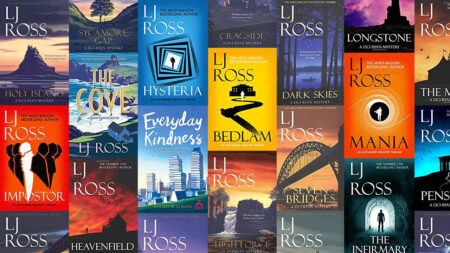Octavia Butler Books in Order (The Patternist series, The Xenogenesis Trilogy, Kindred)
Octavia Butler (1947–2006) was an award-winning best-selling African-American science fiction author who started writing as a teenager. She sold her first short stories in 1971 and her first novel, Patternmaster, was published in 1975. Patternmaster was the first (and last chronologically) installment in the Patternist series, more followed. She also wrote the Xenogenesis trilogy (during the 1980s), and The Parable series (during the 1990s).
She was inducted by the Science Fiction Hall of Fame in 2010, a mountain on Charon (a moon of Pluto) was named after her in 2018, the landing site of the Perseverance rover was also named after her in 2021 by NASA, and she was inducted to the National Women’s Hall of Fame the same year.
How to read Octavia Butler’s Books in Order?
Reading The Patternist Series (in chronological order)
- Wild Seed (1980) – For a thousand years, Doro has cultivated a small African village, carefully breeding its people in search of seemingly unattainable perfection. He survives through the centuries by stealing the bodies of others, a technique he has so thoroughly mastered that nothing on Earth can kill him. But when a gang of New World slavers destroys his village, ruining his grand experiment, Doro is forced to go west and begin anew. He meets Anyanwu, a centuries-old woman whose means of immortality are as kind as his are cruel. She is a shape-shifter, capable of healing with a kiss, and she recognizes Doro as a tyrant. Though many humans have tried to kill them, these two demigods have never before met a rival. Now they begin a struggle that will last centuries and permanently alter the nature of humanity.
- Mind of My Mind (1977) – For thousands of years, Doro has pursued perfection, experimenting with humanity and seeking out rare – and powerful – talents. His finest creation is Mary, a young black woman who grows up on the rough outskirts of Los Angeles. Doro knows he must handle Mary carefully or risk her ending like his previous experiments – dead, either by her own hand or his. What he doesn’t suspect is that Mary is beginning to learn just how much power she wields. As she comes of age, Mary must harness her newfound abilities to challenge the ruthless man who controls her – and fight to free her people once and for all.
- Clay’s Ark (1984) – Blake Maslin is a doctor. In an alternate America marked by volatile class warfare, he and his twin daughters are taken captive by armed men demanding urgent medical care. In an isolated desert compound, the family encounter a collective of people suffering from an unknown and deadly disease. They appear sickly yet possess unnatural strength, torn between the dangerous compulsion to infect others or to hold on to their own humanity.
- Survivor (1978) – Survivor is the only one of Octavia Butler’s early novels not to be reprinted after its initial editions because she disowned it, calling it “my Star Trek novel.” Survivor depicts the Clay’s Ark disease ravaging the Earth, and Doro’s telepathic descendants asserting control over what remains of humanity. One group of regular humans decides to escape Earth to a new planet, where they struggle to co-exist with the species that already lives there.
- Patternmaster (1976) – In the far future, the human race is divided into two groups striving for power. The Patternmaster rules over all, the leader of the telepathic Patternist race whose thoughts can destroy or heal at his whim. The only threat to his power are the Clayarks, mutant humans created by an alien pandemic, who now live either enslaved by the Patternists or in the wild. Coransee, son of the ruling Patternmaster, wants the throne and will stop at nothing to get it, even if it means venturing into the wild mutant-infested hills to destroy a young apprentice — his equal and his brother.

- Patternmaster, Clay’s Ark, Wild Seed, and Mind of My Mind were published in a single volume titled Seed to Harvest.
Reading The Xenogenesis Series in Order
- Dawn (1987) – In a world devastated by nuclear war with humanity on the edge of extinction, aliens finally make contact. They rescue those humans they can, keeping most survivors in suspended animation while the aliens begin the slow process of rehabilitating the planet. When Lilith Iyapo is “awakened”, she finds that she has been chosen to revive her fellow humans in small groups by first preparing them to meet the utterly terrifying aliens, then training them to survive on the wilderness that the planet has become. But the aliens cannot help humanity without altering it forever.
- Adulthood Rites (1988) – Akin looks like an ordinary human child. But as the first true human-alien hybrid, he is born understanding language, then starts to form sentences at two months old. He can see at a molecular level and kill with a touch. More powerful than any human or Oankali, he will be the architect of both races’ future. But before he can carry this new species into the stars, Akin must reconcile with his own heritage in a world already torn in two.
- Imago (1989) – For the first time in the humans’ relationship with the Oankali, a human mother has given birth to an ooloi child: Jodahs. Throughout his childhood, Jodahs seemed to be a male human-alien hybrid. But when he reaches adolescence, Jodahs develops the ooloi abilities to shapeshift, manipulate DNA, cure and create disease, and more. Frightened and isolated, Jodahs must either come to terms with this new identity, learn to control new powers, and unite what’s left of humankind — or become the biggest threat to their survival.

- Dawn, Adulthood Rites, and Imago were published in a single volume titled Lilith’s Brood.
Reading The Parable Series in Order (aka the Earthseed series)
- Parable of the Sower (1993) – When global climate change and economic crises lead to social chaos in the early 2020s, California becomes full of dangers, from pervasive water shortage to masses of vagabonds who will do anything to live to see another day. Fifteen-year-old Lauren Olamina lives inside a gated community with her preacher father, family, and neighbors, sheltered from the surrounding anarchy. In a society where any vulnerability is a risk, she suffers from hyperempathy, a debilitating sensitivity to others’ emotions. Precocious and clear-eyed, Lauren must make her voice heard in order to protect her loved ones from the imminent disasters her small community stubbornly ignores. But what begins as a fight for survival soon leads to something much more: the birth of a new faith . . . and a startling vision of human destiny.
- Parable of the Talents (1998) – In 2032, Lauren Olamina has survived the destruction of her home and family, and realized her vision of a peaceful community in northern California based on her newly founded faith, Earthseed. The fledgling community provides refuge for outcasts facing persecution after the election of an ultra-conservative president who vows to “make America great again.” In an increasingly divided and dangerous nation, Lauren’s subversive colony–a minority religious faction led by a young black woman–becomes a target for President Jarret’s reign of terror and oppression. Years later, Asha Vere reads the journals of a mother she never knew, Lauren Olamina. As she searches for answers about her own past, she also struggles to reconcile with the legacy of a mother caught between her duty to her chosen family and her calling to lead humankind into a better future.
Reading The Standalone Novels by Octavia E. Butler
- Kindred (1979) – Dana, a modern black woman, is celebrating her twenty-sixth birthday with her new husband when she is snatched abruptly from her home in California and transported to the antebellum South. Rufus, the white son of a plantation owner, is drowning, and Dana has been summoned to save him. Dana is drawn back repeatedly through time to the slave quarters, and each time the stay grows longer, more arduous, and more dangerous until it is uncertain whether or not Dana’s life will end, long before it has a chance to begin.
- Bloodchild and Other Stories (1995) – Collects six stories, including “Bloodchild” and “Speech Sounds.” “Bloodchild” is set on a distant planet where human children spend their lives preparing to become hosts for the offspring of the alien Tlic. Sometimes the procedure is harmless, but often it is not. “Speech Sounds” is about a near future in which humans must adapt after an apocalyptic event robs them of their ability to speak.
- Fledgling (2005) – This is the story of an apparently young, amnesiac girl whose alarmingly unhuman needs and abilities lead her to a startling conclusion: She is in fact a genetically modified, 53-year-old vampire. Forced to discover what she can about her stolen former life, she must at the same time learn who wanted-and still wants-to destroy her and those she cares for and how she can save herself.

- Unexpected Stories(2014) – Collects two stories. The novella “A Necessary Being” is about Tahneh’s father who was a Hao, one of a dwindling race whose leadership abilities render them so valuable that their members are captured and forced to govern. When her father dies, Tahneh steps into his place, both chief and prisoner, and for twenty years has ruled without ever meeting another of her kind. She bears her loneliness privately until the day that a Hao youth is spotted wandering into her territory. As her warriors sharpen their weapons, Tahneh must choose between imprisoning the newcomer-and living the rest of her life alone. The second story, “Childfinder,” is about a disaffected telepath who connects with a young girl in a desperate attempt to help her harness her growing powers.
Non-Fiction by Octavia E. Butler
- Conversations with Octavia Butler – In interviews ranging from 1980 until just before her sudden death in 2006, Conversations with Octavia Butler reveals a writer very much aware of herself as the “rare bird” of science fiction even as she shows frustration with the constant question,”How does it feel to be the only one?” Whether discussing humanity’s biological imperatives or the difference between science fiction and fantasy or the plight of the working poor in America, Butler emerges in these interviews as funny, intelligent, complicated, and intensely original.
- The Last Interview: And Other Conversations – In this collection of 10 interviews, 3 of them never published, Butler speaks with candor and openness about her work, her imaginative mission, and the barriers she faced as a Black woman working in a genre dominated by white men. The book features an original introduction by science fiction legend Samuel R. Delany, in which he discusses his personal relation with Butler, providing unparalleled insight into her work and life.
If you like our Octavia Butler reading order, you may also want to see our guide to the books of N. K. Jemisin or to The Vorkosigan Saga. Don’t hesitate to follow us on Twitter or Facebook to discover more book series.

















